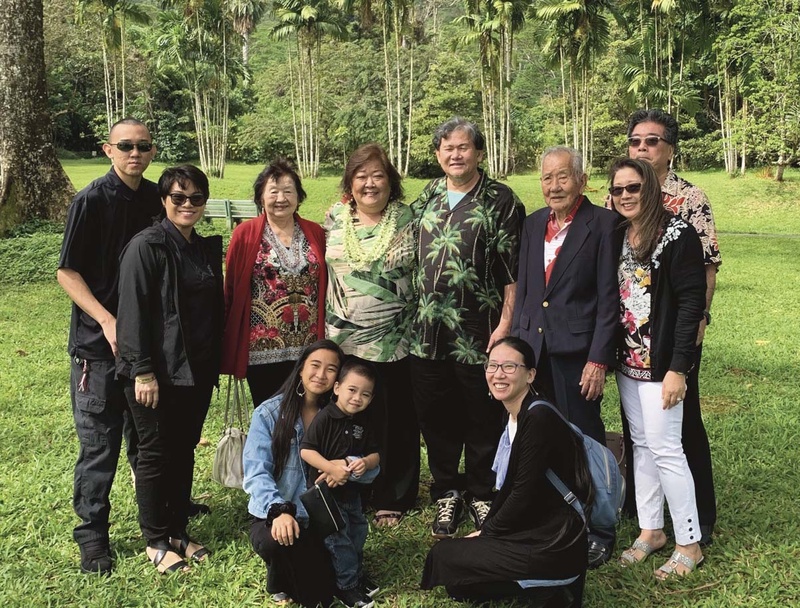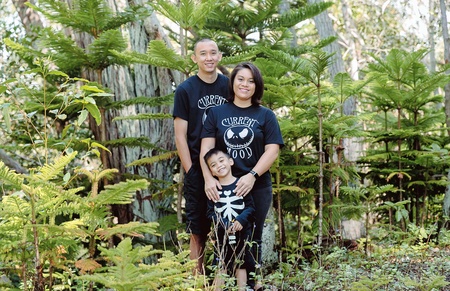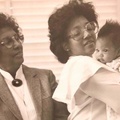Shimizu, who is 36 years old, said he enjoys working with older Deaf people around his parents’ or grandparents’ or godparents’ age, noting that younger kids and teenagers tend to use slang within ASL and make up new signs, and he sometimes doesn’t know what they’re talking about.
“The most important part of being an interpreter,” said Shimizu, “is providing that communication access.” He says that as a local person, he feels like it’s important to him to be there for the Deaf people who have lived on the islands all their life or have lived in Hawai‘i for a long time. “It’s almost like Pidgin, where you feel comfortable with somebody.”
Shimizu said he’s a typical local guy. He grew up racing and fixing-up cars with his dad, who worked as a mechanic for Nissan before becoming a postal worker. As early as he can remember, he was passing tools to his father as they worked on his dad’s classic reddish-orange 1967 Camaro, and later a light blue old Volkswagen bug. He recalls nights when his dad would let him drive around an empty park in Pearl City or around the block when he was 12. “We checked for traffic first,” he said with a laugh.
Shimizu also played volleyball since he was 13 and played in Pearl City’s Junior Varsity Volleyball team. Sometimes it was difficult to interact in sports.
“Back then, the hearing aid wasn’t as great as it is now,” he said. “You had to take it off if it got wet because if the hearing aid gets wet it becomes dysfunctional and you have to let it dry.” He remembers once getting hit in the head with a volleyball and the hearing aid “just flew off.”
But Shimizu said once he got his driver’s license, he fell in love with mechanics and all he wanted to do was work on or race his car. Back in high school, his dad bought him a maroon Honda Civic, which he would race at Hawaii Raceway Park by Campbell Industrial Park. After high school, he followed that passion to Honolulu Community College and Leeward Community College, earning an associates in auto repair.
These days, Shimizu surfs, likes going to the beach and spends Sundays off-roading with his wife, Jaycia, and 6-year-old son, Lucas, at Ka‘ena Point and driving around in his Toyota 4Runner and Toyota Tacoma. “Typical Hawai‘i life,” he laughed.
Free time, however, is in short supply — during the week, he works at HIS in the mornings and at Pearl Harbor at night. His love for cars never wavered, and he spends a few hours one day a week working as a mechanic at MJ Motorsports in Waipio, lifting Toyotas and trucks.
When he’s not working or spending time with Jaycia, Lucas, and godparents, he’s also learning Japanese Sign Language from a friend’s wife and Korean Sign Language from his boss at HIS.
“A lot of people assume that sign language is just general but it’s like a regular language, you know?” Shimizu said, explaining that just like Korean, Japanese, and Chinese spoken languages each sound distinct, its sign language varies, too. “If you go to Australia, they have their own signs — everywhere is really different. I think it’s cool to learn.”
He explains that Japanese sign language, like the Japanese alphabet, combine letters like hiragana and katakana. For example, in ASL, he would sign each letter in Shimizu separately — fingerspelling seven different signs. But in JSL, he only needs to fingerspell three signs — shi, mi, zu. But, unlike spoken Japanese, with Japanese Sign Language, you don’t have to learn the Japanese words to understand the symbols.
Like Shimizu, Lucas’s first language was ASL. As early as three months, Shimizu would say “milk” and sign “milk” in ASL (opening and closing his fist a few times) and by eight months his son was communicating “milk” (and other signs) on his own.
Jaycia and Lucas are both hearing, and while they are still learning ASL, Shimizu often interprets for them with Deaf friends and family when they can’t translate a sign.
“[My son] cannot really express himself in sign language, but in some ways he can,” said Shimizu. “If other people are talking to him in sign language, he can understand, but then he’ll look at me and ask ‘Daddy, how do I sign this?’”
Shimizu said he used to wish he could be one or the other — totally hearing or totally Deaf, so he could fit in one world, but there’s nothing he would really change, because he can’t change being Hard of Hearing.
However, there’s one exception. In the multiverse where Shimizu is hearing, he would be a first responder — a firefighter, police officer or emergency medical technician. He said his boss at HIS tells him he’s like a first responder in his role as an interpreter and laughed and shrugged it off as he relayed the memory, but the two professions are really quite similar.
A first responder and language interpreter share common goals. A first responder is someone with specialized training who is the first to arrive at a scene and provides immediate assistance. An interpreter is someone with specialized training who facilitates communication and enables individuals to participate in various environments like meetings and medical appointments. An interpreter is someone who bridges communication gaps and promotes inclusivity by ensuring equal access to education, healthcare and social participation. In a way, a first responder and interpreter both are responsible for the protection and preservation of life.
Shimizu stressed the importance of learning ASL if you are a caregiver, parent, or teacher of a Deaf child or student. “Learn sign language,” he said. “I strongly, strongly encourage that. Just learn to communicate with them.”
Shimizu said that even though learning ASL may be difficult, “if you know the basic fingerspelling, that’s great!” He said, “I look at my grandparents, and as they became older, they lost some of their hearing, but they know fingerspelling. So at least you have some form of communication.”
Shimizu said lately some doctors push cochlear implants — an electronic device surgically implanted under the skin that works with an external portion behind the ear that bypasses damaged portions of the ear and directly stimulates the auditory nerve. “I’m not totally against cochlear implants; I just don’t like when a parent forces it onto their kid if they’re Deaf or if they lost their hearing,” he said. “I think it should be the child’s decision when they grow up.”
He said sometimes parents will choose to go the cochlear implant route instead of learning sign language and it can affect the connection parents have with kids. “I talk with a lot of kids whose parents are hearing. They want to be in school all day until they have to go home and sleep because when they go home, they don’t get to interact with their own parents.”
Shimizu said sometimes parents would communicate with “home sign” and ask surface-level questions like “you want to eat? “You know that’s not the same communication; there’s no real interaction or a deep conversation.”
Language is a mechanism that binds and unites. Language gives us the freedom to express ourselves and to find human connection. Just as sharing language is a chance to create stronger bonds, an interpreter fills in communication gaps, bringing together what may otherwise remain separate.
Shimizu said one of his favorite things about spending time with his son is just communicating with him. And as a lifelong interpreter, in the middle of the hearing and Deaf world, but nevertheless a connector between those worlds, communication is something he doesn’t take for granted.
For more information about Hawai‘i Interpreting Services, please visit its website at interpretinghawaii.com.
*This article was originally published in The Hawai‘i Herald on September 14, 2023.
© 2023 Summer Nakaishi






